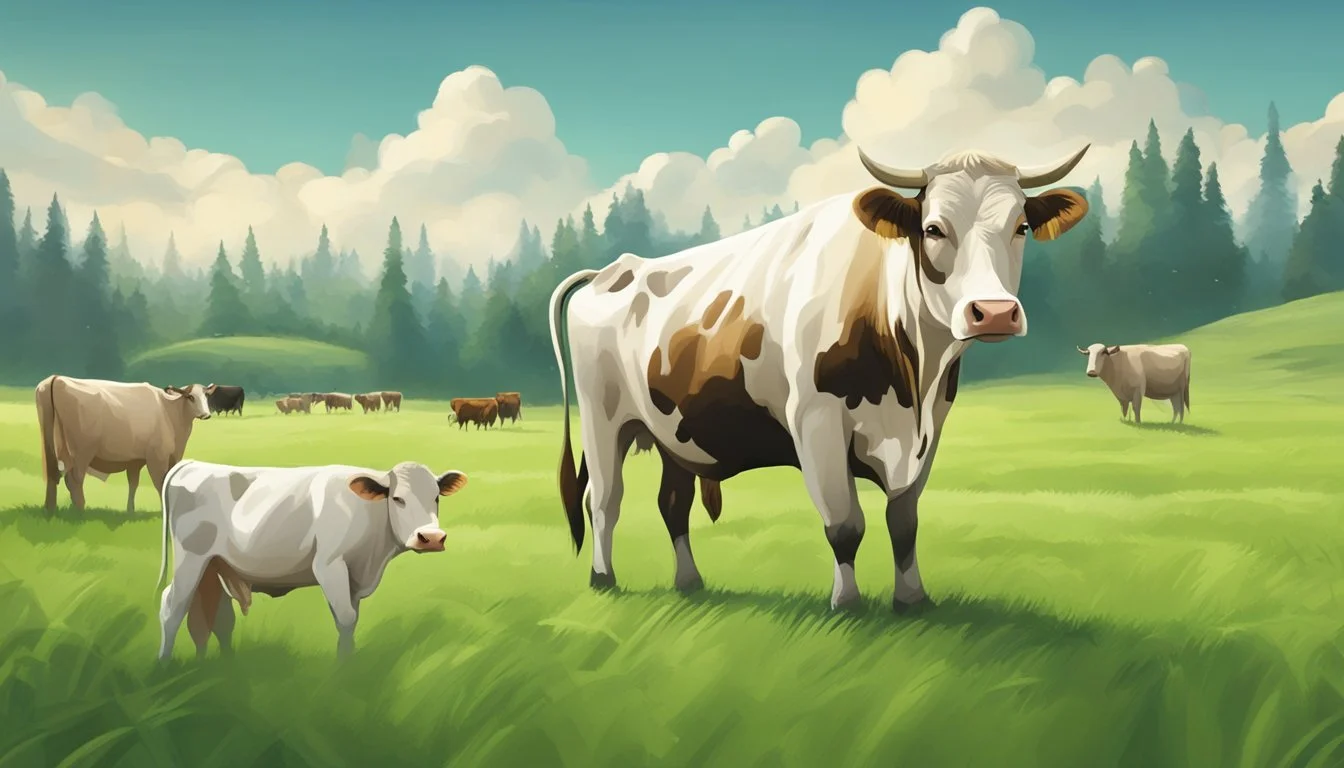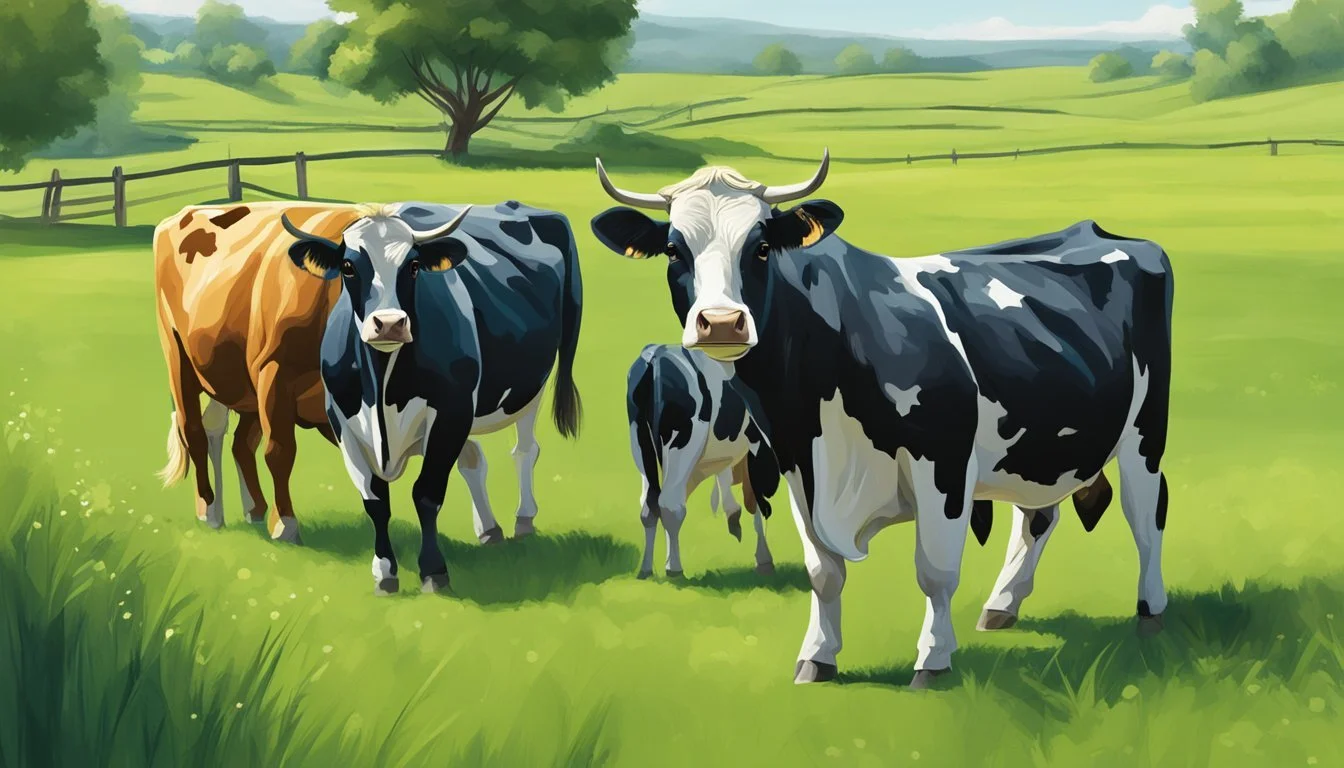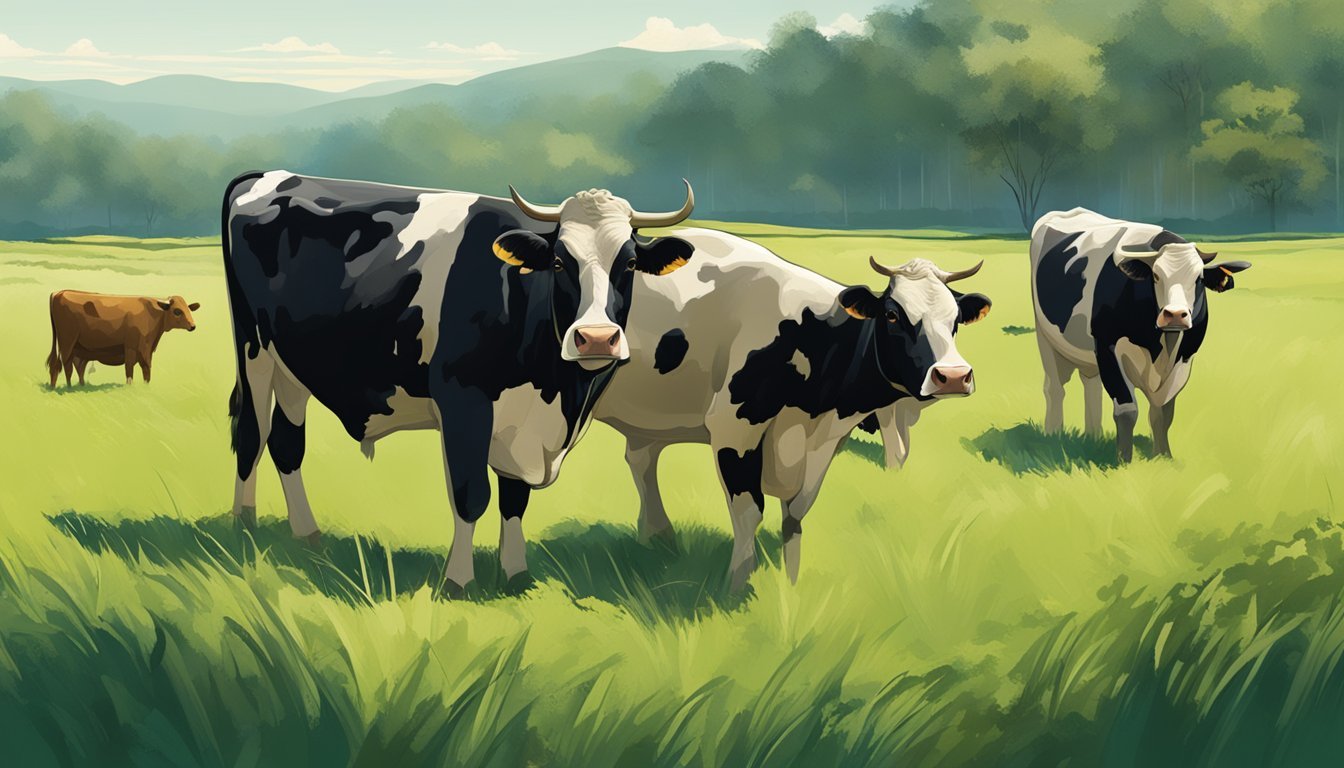How Can I Improve the Genetics of My Cattle Herd
Efficient Breeding Strategies Revealed
Improving the genetics of a cattle herd is paramount for any beef operation aiming to enhance productivity, reproductive performance, and profitability. Genetic improvement involves selecting and propagating desirable traits within the herd, leading to better growth rates, milk production, and disease resistance. One primary method is through the careful selection of sires, as sire selection has a significant impact on herd genetics; a bull's genetic material is passed on to numerous offspring each year.
In the quest for genetic advancement, producers also employ strategies such as crossbreeding, which can introduce hybrid vigor and improve reproductive rates and overall performance of the herd. Moreover, keeping pace with technology, many breeders incorporate genomics to gain a more precise understanding of an animal's genetic potential. Genomic-enhanced Expected Progeny Differences (GE-EPDs) have become a valuable tool, allowing breeders to make more informed decisions with quantifiable genetic data.
Thus, matching cattle genetics with the environment and optimizing management practices is critical for maximizing reproductive success and long-term herd sustainability. Producers can focus on specific traits relevant to their operation's goals, knowing that genetic decisions made today will impact their herd for generations to come.
Understanding Cattle Genetics
In cattle farming, grasping the concepts of genetics is essential for breeding strategies aimed at genetic improvement and managing genetic differences within a herd.
Basics of Genetics and Heredity
Genetics is the study of heredity, focusing on how certain features or traits, such as milk production capacity or growth rate, are passed down from parents to offspring. At the core of genetics are genes, the basic units of heredity, which are found on chromosomes within the cattle's cells. Every cow inherits a set of genes from both its sire (father) and dam (mother), which combine to determine its unique genetic makeup.
Cattle heredity functions through the transmission of DNA, where dominant and recessive genes play pivotal roles in trait expression. Dominant genes overshadow recessive ones, resulting in the dominant trait’s expression. For instance, if one gene code contributes to high milk production and is dominant, calves are more likely to express this trait even if the other gene is for lower production.
Genetic Variation and Importance
Genetic variation among cattle is what allows breeders to select and cultivate desired traits within a herd. This variation comes from mutations, gene combinations, and the introduction of new genetics from different breeds or individuals. It's the foundation of selective breeding and genetic improvement strategies.
For breeders interested in enhancing certain traits, understanding Expected Progeny Differences (EPDs) becomes invaluable. These are estimates predicting how future progeny of a bull or cow might perform compared to average progeny, based on their genetic potential for specific traits.
Selective breeding for desirable traits, such as disease resistance or improved fertility, capitalizes on genetic variation to progressively enrich the herd’s genetic quality. Breeding decisions are made to pair animals with complementary traits, thereby ensuring the likelihood of passing on positive characteristics to the next generation. This careful selection benefits the overall health, efficiency, and productivity of the cattle population.
Selection Strategies
Improving the cattle herd genetics is integral to enhancing overall herd quality. Utilizing structured selection strategies enables producers to make informed breeding decisions, which invariably influence herd performance.
Principles of Selection
Selection is the cornerstone of genetic improvement, focusing on the most desirable traits for propagation. It operates under the principle that only individuals with superior genetics are bred. Modern techniques involve using Expected Progeny Differences (EPDs) which provide estimates of the genetic potential an animal will pass on to its offspring. By comparing these differences, producers can identify the most promising animals for achieving specific breeding objectives. Selection indexes further streamline the process by combining multiple EPDs into a single value for easier selection decisions.
Sire and Dam Selection
Sire selection plays a pivotal role due to the sire's significant genetic influence over the herd. When selecting a sire, producers prioritize traits that align with their hereditary goals, paying close attention to EPDs and their accuracy. Dams contribute to half of the genetic makeup of their calves, so selecting females with excellent genetics is equally important. For dam selection, look beyond EPDs and consider maternal ability, fertility, longevity, and structural soundness to ensure a productive and sustainable herd.
Reproductive Management
Effective reproductive management in beef cattle is a fundamental aspect of herd profitability and efficiency. It involves optimizing fertility and managing calving and breeding cycles to improve the overall reproductive performance of the herd.
Optimizing Fertility in Herds
To enhance fertility within a cattle herd, producers must consider both the genetic makeup and environmental factors. Selection for fertility traits should prioritize those bulls and cows that exhibit early puberty, strong estrous cycles, and higher conception rates. Implementing these genetic practices to improve beef cattle reproduction can result in a greater number of calves born per year, boosting herd output.
There are additional strategies to improve fertility, such as:
Nutritional management: A diet that meets all of the animals' nutritional requirements can lead to improved fertility. This includes an intake of minerals, vitamins, and proteins that support reproductive processes.
Health protocol adherence: Ensuring that all cattle are up-to-date with vaccinations and are kept in optimal health assists in preventing disease-caused fertility issues.
Managing Calving and Breeding Cycles
Producers must synchronize calving and breeding cycles to achieve reproductive efficiency. This involves understanding and manipulating the cow's estrous cycle for better timing of insemination or natural breeding. For calving ease, selecting genetics that favor traits for easier births in heifers and cows can influence herd success significantly.
Key components of managing these cycles include:
Record-keeping: Meticulously documenting breeding, insemination, and calving dates provides valuable data that can be used to make informed decisions on managing cycles.
Breed-specific management: Different cattle breeds have varied reproduction cycles, which necessitates breed-specific strategies for managing reproduction and genetics.
By focusing on these key reproductive management areas, cattle producers can optimize their herd's genetic potential, resulting in improved reproductive performance and efficiency.
Utilizing Artificial Intelligence
As cattle breeders seek to enhance their herds, artificial intelligence (AI) emerges as a powerful tool for genetic improvement. AI facilitates more refined genetic evaluation and predictive analytics in breeding, offering breeders cutting-edge methods to select traits and manage herds effectively.
AI in Genetic Evaluation
Integrating AI into genetic evaluation allows for a more precise estimation of genetic indexes. Breeders can employ AI algorithms to analyze complex datasets that include an animal's pedigree, genomic information, and performance data. Such analysis leads to highly accurate genetic prediction models that inform breeding decisions. For instance, Bruce and Tena Ketchum leverage AI to improve herd genetics by selecting for desirable traits that ultimately contribute to superior progeny and better herd performance.
Predictive Analytics in Breeding
Predictive analytics, powered by AI, employs statistical models to forecast an animal's future performance based on existing data. This actionable insight can significantly aid in the selection processes, yielding a more efficient breeding strategy with improved outcomes. By analyzing historical data and patterns, AI systems can provide breeders with predictions about traits such as milk production, growth rates, or disease resistance. The integration of AI in the breeding process allows for the development of genetic selection frameworks that can dramatically enhance the genetic quality of cattle herds over time.
Crossbreeding and Heterosis
Understanding the concepts of crossbreeding and heterosis, commonly known as hybrid vigor, is fundamental when aiming to enhance the genetic qualities of a cattle herd. Crossbreeding can exploit the strengths of different breeds, while heterosis refers to the performance boost observed in the hybrid offspring.
Benefits of Crossbreeding
Crossbreeding among cattle can lead to significant improvements in reproductive efficiency, with advantages such as increased live births and survival to weaning. Producers can leverage the phenomenon of heterosis, which often results in progeny that outperform the average of their parents in various traits, especially those related to reproduction and health. For instance, a program that utilizes crossbreeding not only shows more robust calves but also more fertile and longer-living cows.
The generation of hybrid vigor through crossbreeding can boost attributes that are lowly heritable. These less heritable traits, such as fertility and calf survival, are not as easily improved through traditional selection but respond favorably to heterosis.
Implementing Effective Crossbreeding Systems
When implementing a crossbreeding system, a structured approach is vital to maximize heterosis and maintain a high level of genetic diversity. There are various strategies, from simple two-breed rotation to more complex rotational crossbreeding involving multiple breeds. These systems aim to capture heterosis at both individual and maternal levels.
A well-designed crossbreeding system can increase the overall production per cow by substantiating weights of calves weaned, therefore enhancing the productivity of the breeding herd. Selecting the right combination of breeds takes careful planning, and it can be beneficial to integrate breeds with complementary traits to correct deficiencies in the existing herd.
Profitability and Productivity
Improving the genetics of a cattle herd directly impacts both profitability and productivity. Producers can see a return on investment through genetic enhancement efforts that lead to more efficient animals and, in turn, greater yields.
Economics of Genetic Improvement
Return on Investment (ROI): Genetic improvement strategies require an initial investment but can lead to significant benefits in herd efficiency and long-term profitability. For instance, the use of artificial insemination (AI) or the selection of superior breeding stock has associated costs; however, these practices contribute to a herd with better growth rates, disease resistance, and fertility—traits that are economically advantageous.
Cost Versus Gain Analysis: Producers must evaluate the costs of genetic improvements against potential gains. Improved genetics can result in cattle with higher weaning weights, which command better prices in the market. Streamlined production systems that focus on genetic strengths tailored to specific environments can further bolster profitability.
Maximizing Efficiency and Yield
Productive Efficiency: There's a strong focus on producing more with less, ensuring each animal reaches its genetic potential. Selection for traits like feed conversion ratio and carcass quality, both of which are heritable, enables producers to cultivate a more efficient herd.
Yield Optimization: Genetic improvement not only increases the volume of production but also enhances the quality of the yield—essential for maintaining competitiveness in the market. By selectively breeding cattle, producers can ensure that the herd exhibits desirable characteristics, such as increased milk production or better meat marbling, therefore increasing the herd's overall profitable yield.
By integrating targeted genetic practices, cattle producers can develop herds that contribute to a more profitable and productive system, making the best use of resources to achieve optimal outcomes.
Health and Longevity
Improving the genetics of a cattle herd encompasses two key aspects: bolstering herd health and breeding for enhanced longevity. These factors contribute significantly to the stayability of a cow herd, influencing both productivity and profitability.
Monitoring and Improving Herd Health
Herd health stands as the foundation for a robust cattle operation. It is imperative to establish regular health check-ups and vaccination protocols to prevent the outbreak of diseases and to maintain the overall well-being of the herd. Attention should be paid to biosecurity measures to limit the introduction and spread of contagious diseases.
Health Check-ups: Schedule routine veterinary examinations and perform necessary interventions promptly.
Vaccination: Implement a comprehensive vaccination program tailored to your herd's specific needs, considering factors like geographic location and herd size.
Records should be meticulously kept, tracking individual health metrics to identify trends and issues early on. Genetic selection can also prioritize traits for disease resistance which can be augmented by utilizing genetic evaluation tools.
Breeding for Longevity
Longevity—or stayability—refers to the productive lifespan of cattle within the herd and is an economical trait for producers. Breeding for longevity involves selecting for traits that not only enhance the lifespan of cows but also ensure they remain productive and fertile throughout their lives.
Factors influencing longevity include:
Genetic Traits: Carefully select sires with strong longevity traits.
Heterosis: Leverage crossbreeding programs to introduce hybrid vigor, which can increase life expectancy.
By carefully evaluating and selecting for health and longevity, producers can develop a resilient cow herd with an extended productive lifespan, underpinning the success of a cattle operation.
Management Best Practices
Effective management practices are crucial for improving genetics within a cattle herd. These involve strategic culling strategies and maintaining proper nutrition to ensure optimal body condition.
Culling Strategies
Culling is necessary to remove animals that negatively affect the genetic progress of a herd. Producers should prioritize the removal of individuals based on heritable traits that impact reproductive success and overall herd health. For instance, they may cull animals with poor fertility or those that consistently produce offspring with defects. Here's a simple approach to culling:
Fertility: Cows that have not become pregnant after a defined breeding season should be considered for culling.
Health: Regularly eliminate cattle with chronic health issues from the breeding pool.
Temperament: Animals showing aggressive or undesirable behavior can be culled to improve herd manageability.
Production: Low milk production in dams or poor weight gain in offspring can be criteria for culling to enhance herd performance.
Nutrition and Body Condition
Nutrition plays a pivotal role in the reproductive performance and genetic advancement of a cattle herd. A cow's body condition score (BCS) should be monitored regularly as it is directly linked to fertility. Here are key nutritional guidelines:
Adequate Feed: Ensure cattle have access to enough high-quality feed to maintain a BCS of 5 to 7 on a 9-point scale.
Balanced Diet: Their diet should be balanced with the necessary vitamins, minerals, and proteins that support reproductive health and genetic potential.
By adhering to these management best practices, cattle producers can significantly enhance the genetic quality and productivity of their herds.
Genetic Tools and Resources
To improve the genetics of a cattle herd, producers can take advantage of several genetic tools and resources. These tools provide insights into an animal's genetic potential and guide producers in making informed breeding decisions.
Understanding EPDs
Expected Progeny Differences (EPDs) are crucial in the selection process for beef cattle breeding. They quantify how future progeny of the sire are expected to perform relative to a given trait. EPDs consider not only the individual's performance but also the performance of their relatives. For example, when looking at growth EPDs, a higher value may indicate that the offspring will likely be heavier at certain ages, which is a desirable trait for beef production.
Utilizing Genomic Information
Genomics plays a foundational role in enhancing genetic evaluations. By assessing an animal's DNA, genomically enhanced EPDs provide a more accurate estimate of the genetic potential. For producers, the use of genomic tools helps in predicting traits such as feed efficiency, meat quality, and disease resistance. This allows for a more strategic approach to breeding that can lead to faster genetic progress in the herd.
Industry Infrastructure
The backbone of any successful cattle genetics improvement program lies within a well-established industry infrastructure. This infrastructure is critical for enabling effective breeding strategies across different cattle operations.
Role of Breed Associations
Breed associations play a pivotal role in the genetic advancement of cattle herds. They maintain pedigree information and performance data which is essential for making informed breeding decisions. Associations such as the American Angus Association provide resources and tools like Expected Progeny Differences (EPDs), assisting seedstock and commercial producers in selecting superior genetics. They act as a hub for knowledge dissemination and breeding technology developments, impacting both beef and dairy sectors.
Collaboration Among Producers
Collaboration among cattle producers, including both beef and dairy sectors, is fundamental for genetic progress. By working together, producers can pool resources to access advanced reproductive technologies and share superior genetics. This collaborative approach often leads to the formation of co-operatives, where commercial producers benefit from the high-quality seedstock created by dedicated seedstock producers. Through cooperative efforts, the industry can achieve uniformity and breed-specific advancements, ensuring the sustainability and profitability of their operations.







